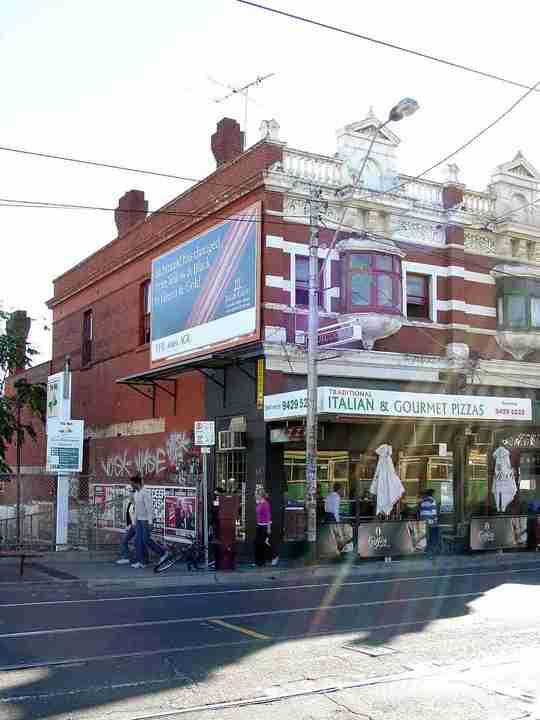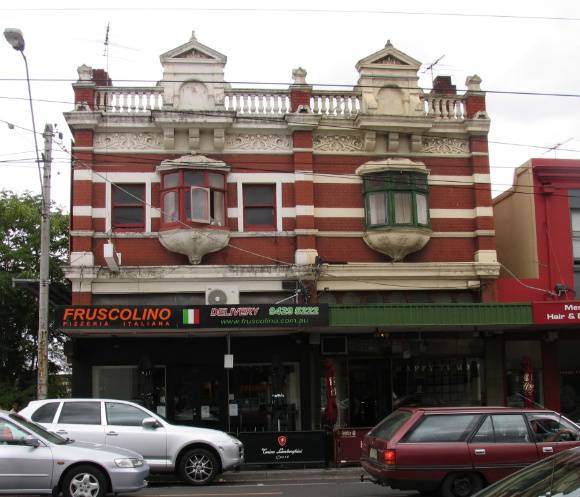| Back to search results » | Back to search page » |
|
Shop & residence
Location468 Church Street, CREMORNE VIC 3121 - Property No 304110 LevelIncl in HO area indiv sig |
|
Statement of Significance
Precinct statement of significance
Component streets include:
Byron Street, Church Street, Kipling Street.
Statement of Significance
What is significant?
Early survey, subdivision and development
Swan Street was designated as a road reserve in Hoddle's Crown survey
of 1837. The north side of Swan Street within the heritage overlay
includes parts of Crown Portions 20 (granted to C Williams), portions
21, 22 (granted to Rev J Docker) and 23 (granted to J McNall), all
sold 1839. By 1853, much of Docker's and Williams' land had been
subdivided: Wangaratta, Lennox, Stanley, Clifton, Docker and Charles
Streets had all been laid out. The precinct also includes parts of
Crown Allotments Nos. 1-8, stretching south to the river and sold in
1849. The Whitehorse Hotel (250 Swan St ) was built on one of these
portions between 1849 and 1855. By 1857 traders in Swan Street
included butchers, drapers, fruiterers, tailors, shoemakers,
hairdressers and hoteliers, including the Swan Inn, Dover and Royal
Hotels by 1858. (131) Swan Street was fully developed by 1889 and the
roadway was sealed or macadamised in 1901.
Transport
The Swan Street area was first served by public transport after the
Melbourne and Suburban Railway Co. was authorised to build a line from
Princes Bridge Station to Windsor, with a proposed branch line through
Richmond to Hawthorn open as far as Punt Road in 1859. The line was
later relocated to off Swan Street, serving Richmond Station. The
extension from Punt Road to Church Street (now East Richmond Station)
and Picnic Station (between Burnley and Hawthorn) opened in 1860,
serving the pleasure grounds at Richmond Park (now Burnley Park). The
line to Cremorne Station (south of Richmond, near the Yarra) opened
1859 (132) and the level crossing across Swan Street was replaced by
an overhead bridge in 1887.(133) While Victoria Street and Bridge Road had been served by cable trams
since the mid-1880s, the electric tram service in Swan Street, which
duplicated the nearby railway, was established in 1916.(134) Swan
Street itself originally terminated at the Survey Paddock (later
Richmond Park, now Burnley Park), but was extended to the Yarra River
between 1874 and 1888. The introduction of electric trams to Swan St
also encouraged further development.
Dimmey's
Dimelow and Gaylard's original store in Swan Street Richmond was
burnt out in 1906, and in 1907, a new store was built by Robert
McDonald and the architects were HW & FB Tompkins. It was renamed
'Dimmey's Model Stores' in 1912. The distinctive clock tower, which is
topped with a copper ball, was added between 1908 and 1916.
Conclusion
Some 24% of the buildings identified along Swan St are from the early
Victorian-era and nearly 26% are individually significant, being a
high percentage among other Heritage Overlay Areas but typical for the
City's old commercial strips, with Brunswick St being 21%, Smith
Street 27%, Queens Parade at 33%. Individually significant buildings
identified range from the 1880s-1920.
Main development era
The main development period of the Swan Street Heritage Overlay Area
is that of the Victorian and Edwardian-era, with a contribution from
well-preserved inter-war buildings and individually significant
buildings from any period.
Contributory elements
Contributory elements include (but not exclusively) typically
attached Victorian-era and Edwardian-era mainly two-storey shops and
residences having typically: . Facade parapets, with pitched roofs behind . Two storey wall heights, . No front or side setbacks; . Face brick (red, dichrome and polychrome) or stucco walls; . Corrugated iron and slate roof cladding; . Chimneys of either stucco finish (with moulded caps) or of face red
brickwork with corbelled capping courses; . Post-supported street verandahs as shown on the MMBW Detail Plans (135), . Less than 40% of the street upper wall face comprised with openings
such as windows; . Display windows, timber or tiled shopfront plinths, and entry
recesses at ground level; and . Red brick, storage or stable buildings at the rear or side lane
frontage for some properties; Contributory elements also include: . Well preserved buildings from the inter-war period and individually
significant buildings from all periods; . Public infrastructure, expressive of the Victorian and
Edwardian-eras such as bluestone pitched road paving, crossings, stone
kerbs, and channels, and asphalt paved footpaths
How is it significant?
HO335 Swan Street Heritage Overlay Area, Richmond is aesthetically
and historically significant to the City of Yarra (National
Estate Register [NER]Criteria E1, A4)
Why is it significant?
The Swan Street Heritage Overlay Area, Richmond is significant: . As one of the two major early commercial thoroughfares in the
former City of Richmond, with a good collection of well-preserved,
mainly Victorian and Edwardian commercial buildings, containing a
mixture of shops, hotels and other commercial buildings, many of which
are substantially intact at first floor level, with a number of
historic shopfronts at ground floor, including those dating from the
interwar period; . For the landmark or individually significant buildings from all
eras including early hotels, from the gold rush era, and famous retail
stores such as Maples, Dimmey's and Ball and Company, many with
architecturally significant upper facades; and . As a good illustration of commercial architectural styles in the
City, from the late 1850s to the inter-war period.
References
131 Electoral Roll. 1856-57. 132 Harrigan, p 54. 133 White, op cit. 134 City of Richmond. Copping It Sweet. p 71 135 See MMBW Detail Plan 1196 of 1899
Group
Residential buildings (private)
Category
Residence





